




Know How to Differentiate Between SN1 and SN2 Reactions
SN1 and SN2 reactions are key concepts in organic chemistry and play a significant role in JEE Main 2025 preparation. These substitution reactions help understand the mechanisms behind nucleophilic attack and reaction rates, influenced by substrate structure, nucleophile strength, and solvent type. To help you prepare effectively, this guide covers important concepts, reaction mechanisms, and tips for solving related exam questions. Strengthen your understanding of these reactions to approach organic chemistry confidently in JEE Main 2025.
JEE Main Chemistry Syllabus JEE Main Chemistry Revision Notes JEE Main Chemistry Important Questions JEE Main Chemistry Difference Between JEE Main Chemistry Question Papers
Overview of SN1 and SN2 Reactions
A nucleophile is defined as an atom or a molecule that contains a pair of electrons to donate to another atom or molecule. In simple terms, we can say that these are electron-rich species with unused electrons in their orbit. Nucleophiles can be anions or neutral anions that are negatively charged ions. For example, Hydroxide ion (OH-).
Neutral nucleophiles are molecules that contain a lone pair of electrons with zero charges on them. For example, Ammonia (NH3). Even though the molecule ammonia is neutral, the nitrogen atom contains a lone pair of electrons, which can be donated to electron-deficient species.
A substitution reaction is a type of chemical reaction, where the atom or the functional group of a molecule gets substituted by another atom or a functional group. Substitution reactions can be of two types: Electrophilic Substitution Reactions and Nucleophilic Substitution Reactions.
A nucleophilic substitution reaction is a reaction in which one nucleophile replaces the other nucleophile in a molecule. The molecule on which substitution occurs is known as the ‘substrate’, and the group that leaves is called ‘leaving group’. In this topic, we will learn about the types of nucleophilic substitution reactions along with their mechanisms.
What are SN1 and SN2 Reactions?
SN1 and SN2 reaction mechanisms belong to nucleophilic substitution reactions. To understand these reaction mechanisms better, it is important to learn the basics of nucleophilic substitution reactions. SN2 reaction (substitution, nucleophilic, bimolecular ) is a one-step mechanism, following second-order kinetics whereas SN1 is a two-step mechanism, following first-order kinetics. In the SN1 mechanism, the product is formed via the formation of carbocation, whereas in the SN2 mechanism the reaction occurs through a transition state.
Mechanism of SN2 Reaction
Let us consider the reaction between methyl chloride and hydroxide ions to produce methanol and chloride ions. In the SN2 reaction, the rate of reaction depends on the concentration of both the reactant, i.e. methyl chloride and hydroxide ions. In other words, rate
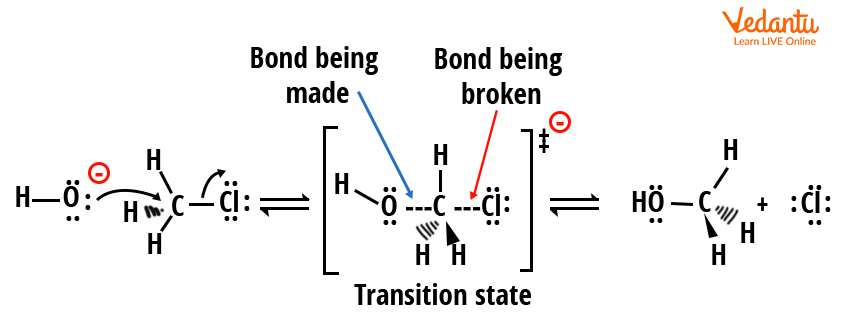
Mechanism of SN2 reaction
Hence, in this reaction both the alkyl halide and nucleophile simultaneously take part in the rate-determining step of the SN2 reaction. Thus, SN2 is a concerted reaction i.e. step reaction. SN2 reaction occurs through the transition state in which the carbon atoms are simultaneously bound to the incoming nucleophile OH- ion and the outgoing leaving group chloride ion.
Due to the instability of the transition state, it decomposes into product methanol and leaves a group of chloride ions. In the SN2 reaction, the attack of the nucleophile occurs from the back side where the leaving group leaves from the front side. It results in the inversion of the configuration which is also known as ‘Walden Inversion’.
Mechanism of SN1 Reaction:
Let us consider the reaction between tert-butyl bromide and the hydroxide ion to yield tert-butyl alcohol and chloride ion.
SN1 reaction follows first-order kinetics, that is, the rate of reaction depends on the concentration of only one reactant, which is tert-butyl bromide and is independent of the concentration of hydroxide ion. Rate
Step 1: This step is slow, reversible and the rate-determining step. Here, tert-butyl bromide undergoes ionisation to produce tert-butyl carbocation and the bromide ions.
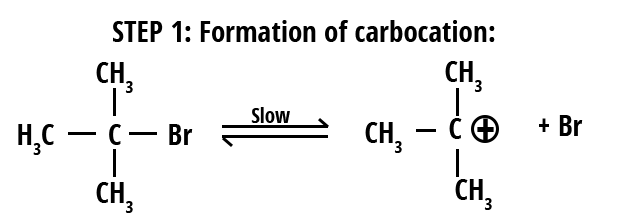
Step 1. Formation of carbocation
Step 2: Since the carbocation is very reactive, it is immediately attacked by the nucleophile, i.e, OH- to give the substitution, that is tert-butyl alcohol.
The step is fast and therefore, does not affect the rate of reaction.
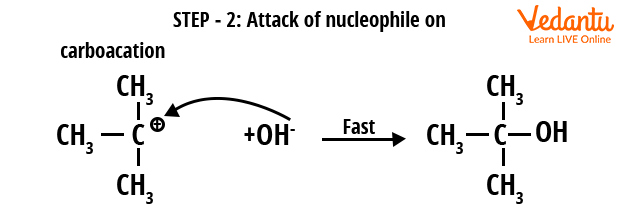
Step 2. Attack of nucleophile
Stereochemistry of SN2 and SN1
Stereochemistry of SN2 reaction: As we previously discussed, in an SN2 reaction, the attack of a nucleophile occurs to form the back side, that is, in the direction opposite to the one where the halogen leaves. As a result, SN2 is accompanied by inversion of configuration just the same way an umbrella turns inside out. This inversion of configuration is also called ‘Walden inversion’. Hence in SN2, there is a complete inversion of configuration.
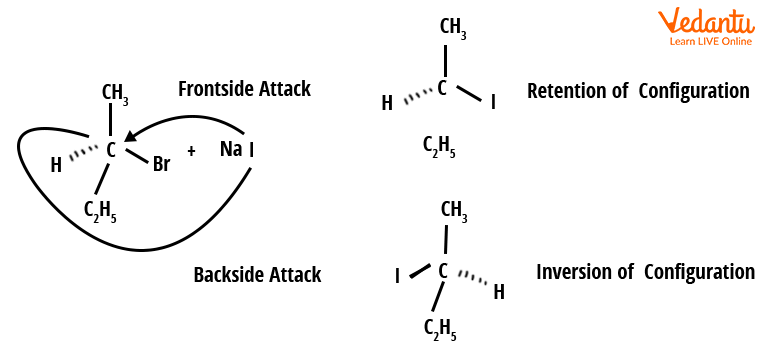
Stereochemistry of SN2
Stereochemistry of SN1: In the SN1 reaction, if the alkyl halide is optically active, then the product is a racemic mixture. In the SN1 reaction, nucleophile attacks occur from both the backside and front side. However, backside attack is predominant. We can say that the nucleophile attack in SN1 carbocation can occur with equal ease from both the front and the backside. Given the racemic mixture of the product, the overall result is generally racemisation with some inversion i.e, partial racemisation occurs.
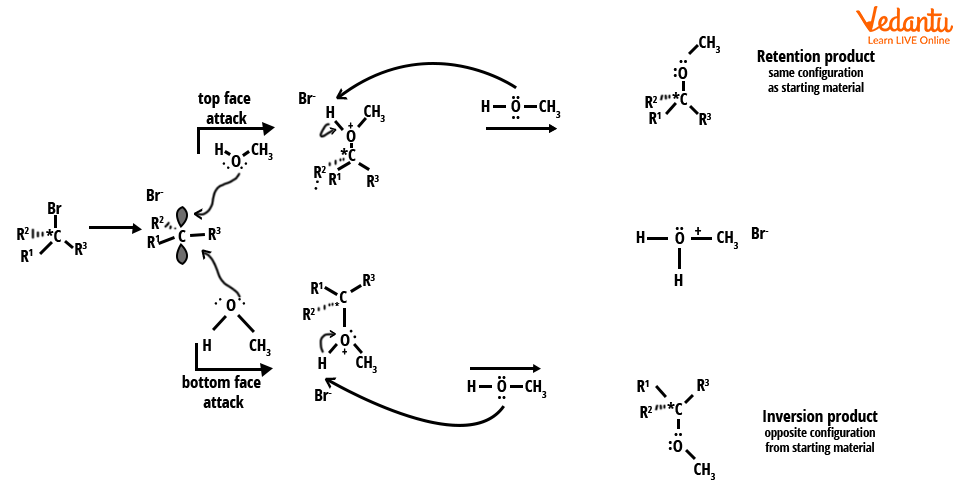
Stereochemistry of SN1
Distinguish Between SN1 and SN2 Mechanism
Significance of SN1 and SN2 Reactions and their Mechanisms for JEE Main 2025
SN1 and SN2 reactions are vital for understanding organic chemistry, especially in substitution mechanisms, making them highly significant for JEE Main 2025.
These concepts are frequently tested in exam questions involving reaction intermediates, stereochemistry, and determining reaction types.
Typically, questions from this topic appear in 2-3 organic chemistry-related problems each year, focusing on the conditions, reactivity, and mechanisms of SN1 and SN2 processes.
Mastery of these reactions boosts your ability to solve complex organic chemistry problems effectively.
Tips for JEE Main 2025 Preparation
Know the Syllabus: Focus on high-weightage topics in Chemistry.
Make a Study Plan: Allocate time for concept building, practice, and revision.
Strengthen Basics: Use NCERT textbooks to build a strong foundation.
Practise Regularly: Solve past papers and take topic-wise mock tests.
Time Management: Learn to balance time between subjects and questions.
Revise Often: Maintain short notes and revise formulas frequently.
Use Quality Resources: Refer to trusted books and platforms like Vedantu for guidance.
Mock Tests: Take weekly mock tests and work on weak areas.
Consistency: Stick to your plan and maintain discipline.
Self-Care: Get enough rest, eat healthily, and stay positive.
Conclusion
To sum it up, SN1 and SN2 are two types of nucleophilic substitution reactions explained by taking Sn1 and Sn2 reaction examples. A nucleophile is defined as an electron-rich atom or molecule. It can be in the form of an anion (negatively charged ion) or in the form of a compound that has one lone pair of electrons. A nucleophilic substitution reaction involves the replacement of one functional group or atom with another anion or atom.
JEE Main 2025 Subject-Wise Important Chapters
The JEE Main 2025 subject-wise important chapters provide a focused strategy for Chemistry, Physics, and Maths. These chapters help students prioritise their preparation, ensuring they cover high-weightage topics for better performance in the exam.
Check Other Important Links for JEE Main and JEE Advanced 2025
JEE 2025 needs well-structured study materials. Here are some valuable resources to help you plan your preparation and practice efficiently.






FAQs on Chemistry SN1 and SN2 Reactions and their Mechanisms for JEE Main 2025
1. What is nucleophilicity and how does it differ from basicity?
In a substitution reaction, nucleophilicity refers to a nucleophile's capacity to displace a leaving group. This section discusses several nucleophilicity trends. There is a trend within a period, a trend within a group, a trend depending on the nucleophile's charge and a nucleophile's steric effect. Nucleophiles are also bases. In elimination reactions, they can abstract protons. Although nucleophilicity and basicity are both connected to the availability of the same electron pair, the reactions of a series of nucleophiles do not always follow the same pattern as the reactions of the same species as bases.
2. What is an optically active substance?
The substances which can rotate the plane of polarised light in either direction (left or right ) are called ‘optically active substances’ and the property of substances to rotate the plane of polarised light is called ‘optical activity’. Substances that rotate the plane of polarised light toward the right i.e. in the clockwise direction, are called ‘dextrorotatory’ and denoted by algebraic sign (+). Substances that rotate the plane of polarised right light toward the left i.e. in the anti-clockwise direction, are called ‘laevorotatory’ and are denoted by algebraic sign (-).
3. What are SN1 and SN2 reactions?
SN1 and SN2 reactions are nucleophilic substitution reactions in organic chemistry. SN1 is a two-step mechanism, while SN2 is a one-step mechanism involving a single transition state.
4. What are the factors affecting SN1 and SN2 reactions?
Factors affecting SN1 and SN2 reactions include the structure of the substrate, strength of the nucleophile, nature of the solvent, and leaving group ability.
5. Can you provide SN1 and SN2 reactions examples?
Examples of SN1 reactions include the hydrolysis of tertiary alkyl halides, while SN2 examples include the reaction of methyl bromide with hydroxide ions.
6. Where can I download SN1 and SN2 reactions PDF for JEE Main 2025?
The SN1 and SN2 reactions PDF for JEE Main 2025 is available on Vedantu, providing detailed explanations, solved questions, and practice exercises.
7. How to differentiate between SN1 and SN2 reactions?
SN1 reactions involve a carbocation intermediate and occur in two steps, while SN2 reactions are single-step with a backside attack mechanism and inversion of configuration.
8. What are SN1 and SN2 reactions in terms of kinetics?
SN1 reactions follow first-order kinetics, depending only on the substrate concentration, while SN2 reactions follow second-order kinetics, depending on both the substrate and nucleophile.
9. Why are SN1 and SN2 reactions important for NEET and JEE exams?
SN1 and SN2 reactions are essential for NEET and JEE as they test core organic chemistry concepts like reaction mechanisms, stereochemistry, and rate laws.
10. What are the key differences in stereochemistry between SN1 and SN2 reactions?
SN1 reactions often lead to a racemic mixture due to planar carbocation intermediate, while SN2 reactions result in inversion of configuration because of the backside attack.
11. How do solvents influence SN1 and SN2 reactions?
Polar protic solvents favour SN1 reactions by stabilising the carbocation, whereas polar aprotic solvents favour SN2 reactions by enhancing the nucleophile's reactivity.












